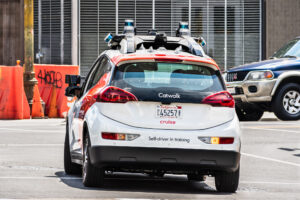
CA DMV investigating Cruise over crash, other incidents during first week of 24-hour service
By onTechnology
General Motors’ Cruise robotaxi service didn’t have a great start during its first week of full 24/7 deployment, which ended with the California DMV saying it had launched an investigation.
Amid safety concerns, including blocking emergency vehicles, California Public Utilities Commission (CPUC) granted driverless deployment permits to the Cruise and Waymo on Aug. 10. The approval makes San Francisco the first major U.S. city with two fleets of driverless vehicles competing for passengers against ride-hailing and taxi services, such as Uber and Lyft.
The DMV announced its investigation on Aug. 18 following a Cruise autonomous vehicle (AV) crash with a firetruck.
“The DMV is investigating recent concerning incidents involving Cruise vehicles in San Francisco,” the DMV said Saturday in a statement to The Associated Press. “Cruise has agreed to a 50% reduction and will have no more than 50 driverless vehicles in operation during the day and 150 driverless vehicles in operation at night.”
Another California DMV investigation launched to determine whether Tesla falsely advertises its driver assist feature Full Self-Driving has been ongoing for more than two years, according to the Los Angeles Times.
Several news outlets report that the robotaxi continued into an intersection on a green light while a firetruck with sirens and lights on headed toward it. One passenger was inside the AV and sustained non-life-threatening injuries, according to the Los Angeles Times.
Another Cruise AV with a passenger inside was involved in a separate crash in San Francisco the same night, according to the San Francisco Chronicle.
The Los Angeles Times also reported on two other incidents earlier in the same week. The first included a group of Cruise robotaxis that drove together into the city’s North Beach district on Aug. 11. They froze in place, sat for 15 minutes blocking an intersection, then continued on. Cruise blamed cellphone service.
On Aug. 15, a Cruise robotaxi ignored construction signs and drove into a stretch of wet cement. It was later removed by Cruise workers.
In an Aug. 18 blog post regarding the collision with a firetruck, Cruise’s San Francisco Market General Manager Greg Dietrerich wrote, “First and foremost, our primary concern remains with our passenger and their well-being. We have been in contact to offer support and will remain in touch.
“In terms of what occurred around the scene of the collision there are many aspects that looked typical from the AV’s perspective and several factors that added complexity to this specific incident. The AV positively identified the emergency vehicle almost immediately as it came into view, which is consistent with our underlying safety design and expectation.
“It is worth noting, however, that the confines of this specific intersection make visual identification more challenging – for humans and AVs alike – as it is significantly occluded by buildings, meaning that it is not possible to see objects around the corner until they are physically very close to the intersection.”
Dietrerich added that the AV’s ability to figure out the firetruck’s path was complicated by it moving into oncoming traffic to bypass the traffic light.
“Cruise AVs have the ability to detect emergency sirens, which increase their ability to operate safely around emergency vehicles and accompanying scenes,” Dietrerich wrote. “In this instance, the AV identified the siren as soon as it was distinguishable from the background noise. The Cruise AV did identify the risk of a collision and initiated a braking maneuver, reducing its speed, but was ultimately unable to avoid the collision.”
He noted that during the first seven months of this year its AVs have encountered more than 168,000 emergency vehicles in the city.
“We realize that we’ll always encounter challenging situations, which is why continuous improvement is central to our work. We will continue to work in partnership with regulators and city departments on EMV interactions to reduce the likelihood of incidents like these happening again.”
Images
Featured image: Cruise tests a self-driving vehicle on San Francisco city streets in 2019. (Credit: Sundry Photography/iStock)
